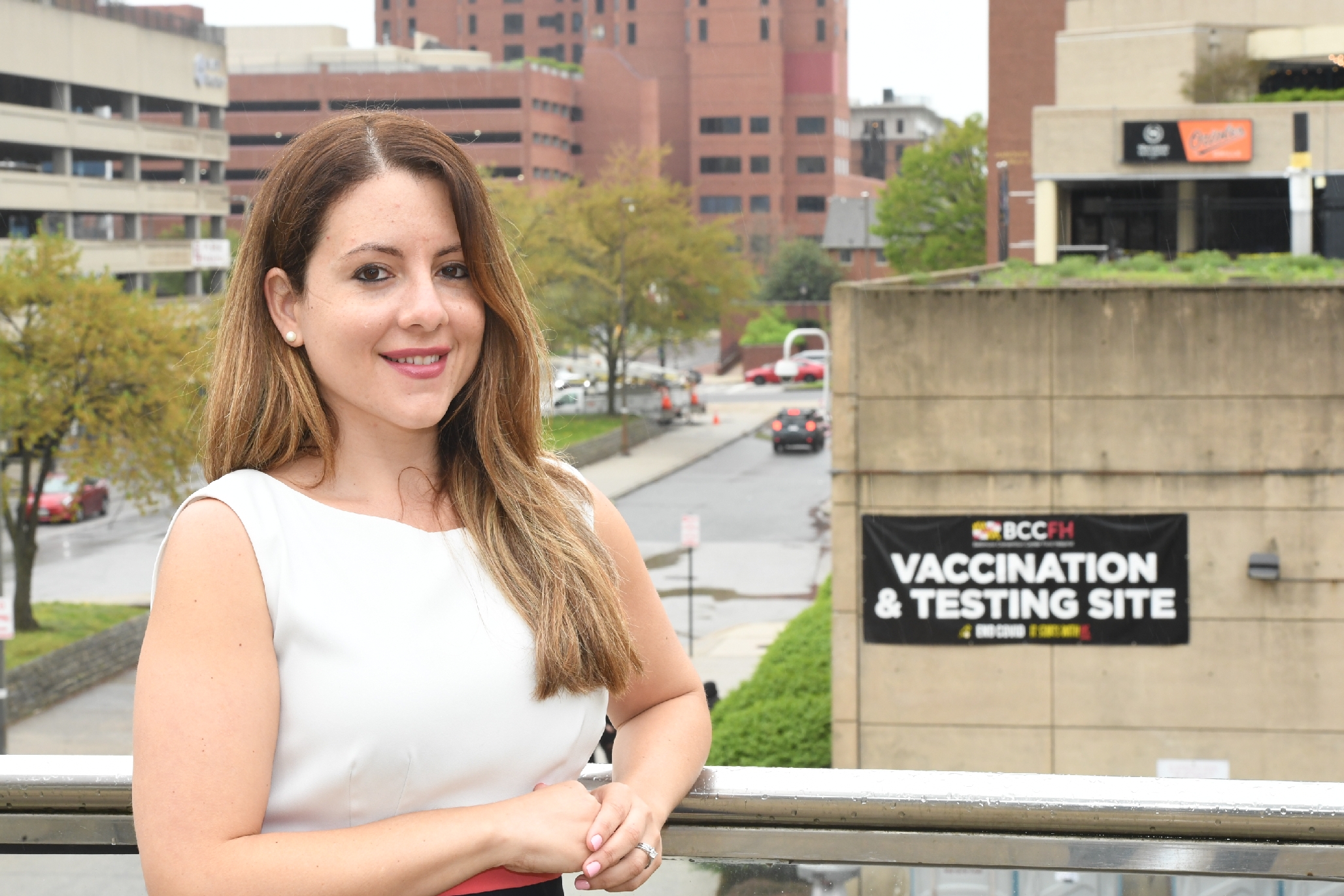Spring 2021
A COVID Winter: Baltimore
– David Glenn
Conversations with Glorimar Rivera-Quiñones: Chief Pharmacist, Baltimore Convention Center Field Hospital
The Wilson Quarterly spoke with a number of those involved in battling COVID-19 or covering its impact through a dark and challenging winter. Glorimar Rivera-Quiñones spoke with David Glenn.
Glorimar Rivera-Quiñones never wanted a quiet job. When she was in pharmacy school several years ago, she found that her favorite clinical rotations were in critical-care units.
“I discovered that I like participating in medical emergencies,” she says. “I really enjoy helping patients who are acutely ill.” After she graduated, she worked the night shift for two years as a clinical pharmacy specialist in an intensive care unit in Baltimore, which suited her fine.

Last year, Rivera-Quiñones was plunged into an emergency on a different scale: the COVID-19 pandemic. To prevent local hospitals from overflowing, the city of Baltimore decided to set up a 250-bed field hospital on the floor of the Baltimore Convention Center. The site would be jointly operated by the University of Maryland Medical System (Rivera-Quiñones’s employer) and Johns Hopkins Medicine. Rivera-Quiñones was assigned to be the field hospital’s pharmacist-in-charge.
Her first task: converting the convention center’s food court into a functioning pharmacy that could meet the standards of state and federal regulators. “In three weeks,” she says, “we had to find supplies, design the space, and create the workflows. It was a new experience for all of us. When the Board of Pharmacy came to inspect – I don’t think any of them had ever seen a pharmacy in a food court before.”
Preparing for the Worst (April/August 2020)
The field hospital opened its doors on April 19, 2020, a few weeks before the first wave of infection peaked in Maryland. The idea was to provide a release valve for hospitals. They would have a place to send patients who were past the worst days of their illness, but not yet well enough to go back to their homes or nursing facilities. The initial thought, Rivera-Quiñones says, was that it would only be required for a few months.
The Baltimore site was just one of 43 field hospitals that opened in the United States in April 2020, in what is said to be the largest wave of field medicine since the Civil War. Some of these, like the U.S. Navy medical ships that docked in Manhattan and Los Angeles, were intended to treat non-COVID patients. But the majority were, like the Baltimore project, designed for low-acuity COVID patients.

In the early weeks of the Baltimore field hospital, Rivera-Quiñones was sometimes the only Spanish-speaking clinician on site. Occasionally, when patients were admitted, she would gown up, walk into the hot zone, and try to answer their questions.
“A lot of patients were reluctant to come here,” she says, “because they hear the term ‘field hospital’ and think of something crowded and dirty. But we have partitions, and we’ve been able to make the space look and feel almost like a normal hospital.” (If, that is, you ignore the fifty-foot ceilings.)
A Neglected Treatment (August/November 2020)
More than a year later, the Baltimore field hospital is still in business. It has never come close to filling all of the 250 beds on the convention center floor. Even during the worst waves of COVID-19, the field hospital’s patient census has topped out at around 50.
But at this point, the inpatient beds are only a small part of the Baltimore site. Last summer they added a COVID-19 testing program, where hundreds of people per day are swabbed for the virus. Then, in November, Rivera-Quiñones and her colleagues established an outpatient infusion center for delivering monoclonal antibody treatments against COVID-19. These treatments deploy laboratory-created antibodies that are tailored and mass-produced to fight specific features of the virus.
"When the Board of Pharmacy came to inspect – I don’t think any of them had ever seen a pharmacy in a food court before.”
As was common across the country, the number of people who were given these antibody treatments proved to be unexpectedly low. Rivera-Quiñones and her team had prepared to treat as many as 60 patients per day, but instead averaged fewer than 15 per day during the clinic’s first four months of operation.
“I think part of the issue is that it has been challenging to inform primary care providers about these medications and about how to refer their patients,” Rivera-Quiñones. “And the criteria in the FDA’s emergency use authorization have been quite strict and complex.”
In order to be referred for monoclonal antibody treatments, a patient must have (1) a positive COVID test; and (2) not be so sick that they require hospitalization; and (3) not be more than ten days past the initial onset of symptoms; and (4) have an underlying medical condition that places them at high risk of hospitalization.
Ramping Up to Vaccinate (December 2020/February 2021)
As 2021 began, Rivera-Quiñones was handed another task: The Convention Center would open a vaccination clinic. “Once this was decided, we only had two weeks to get ready,” she says. “This was by far the most challenging part of this entire year.”
Because the process of handling and preparing the Pfizer vaccine is so complex, Rivera-Quiñones spent a day shadowing her colleagues at the University of Maryland Medical Center as they vaccinated health workers.
She also had to staff up – and quickly. Rivera-Quiñones started out last spring with a skeleton crew of a half-dozen pharmacists and pharmacy techs, but she now supervises a staff of more than forty people.

Unlike the mass-vaccination site at a football stadium a mile away, the convention center’s program is targeted toward specific vulnerable populations. Appointments are given preferentially to residents of six of the poorest zip codes in Baltimore City.
“Our patients sometimes walk past the pharmacy on their way to the vaccination clinic,” Rivera-Quiñones says. “You can see in their faces that they're happy, they're grateful. That’s been a very rewarding thing. We’re all motivated, even though we’re working long days. There’s finally a sense of hope.”
Most mornings, Rivera-Quiñones is on site by 5 a.m., leading the preparation of vaccine doses. The entire process is meticulously timed: The Pfizer vaccine must be thawed and then mixed with a saline diluent – after which it must be administered within six hours. “We have a massive production line in the morning,” she says. “We need to have 600 doses ready to go before our first people arrive.”
The field hospital doesn’t have an ultracold refrigerator to store the Pfizer vaccine, and it also doesn’t have an air hood for the safe preparation of IV medications. For those reasons, Rivera-Quiñones and her colleagues have had to develop an elaborate system of couriers who ferry vaccines and medications along four blocks of downtown Baltimore, from the University of Maryland Medical Center to the Convention Center.
A Late Surge (March/April 2021)
On the rare days when she isn’t working at the field hospital center, Rivera-Quiñones casts her eye toward Puerto Rico, where she was born and raised. Both her parents are medical technologists there. “They’re on the front lines just as much as I am,” she says. “They’re the people running the tests for COVID-19. I grew up visiting them in their labs, and that was part of why I wanted to become a health care professional.”
As March ran into April, all four components of the Baltimore Convention Center – the inpatient beds, the testing site, the infusion center, and the vaccination clinic – were getting more crowded.
We have a massive production line in the morning. We need to have 600 doses ready to go before our first people arrive.”
“It’s frustrating to see the case numbers accelerating again,” says Rivera-Quiñones. “Some people who are not fully vaccinated are going to bars, restaurants, and not wearing their masks or social distancing.”
Fourteen months into the pandemic, Rivera-Quiñones is steeling herself for her busiest season yet.
David Glenn is an oncology nurse in Maryland. He has written for The Chronicle of Higher Education, Dissent, and The New York Times Book Review.
Cover Photograph: A waxing moon above a statue atop the Peggy Stewart Monument in Baltimore, MD on February 25, 2021. (AP Photo/Julio Cortez)
